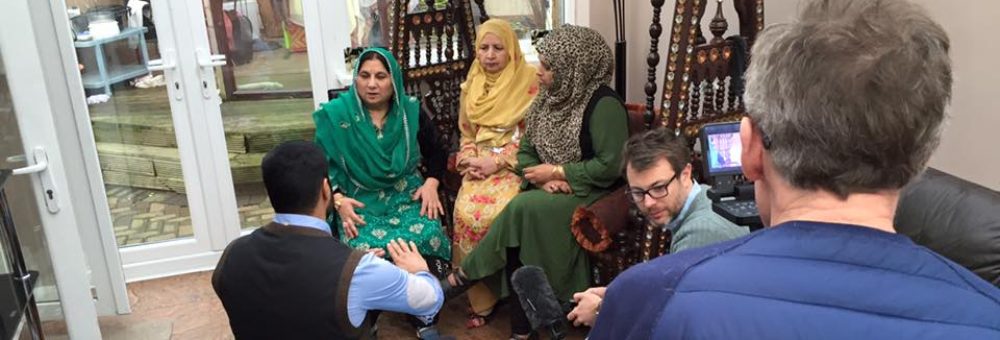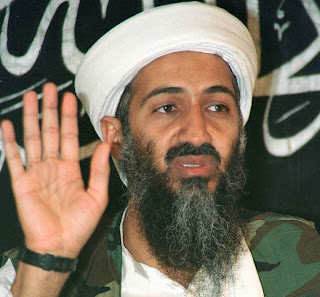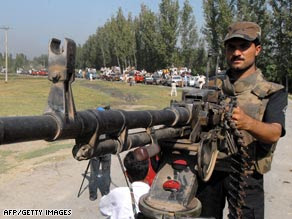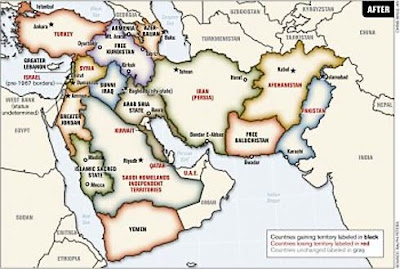 In Pakistani-administered Kashmir this small refugee camp is home to some 600 people who have fled Indian-administered Kashmir, 16km from the line of control. This is the line of the world’s most militarised zone. Since the Mumbai attacks and continued Indian allegations of Pakistani involvement tensions are once again forcing people to fortify their bunkers as they brace themselves for a potential confrontation.
In Pakistani-administered Kashmir this small refugee camp is home to some 600 people who have fled Indian-administered Kashmir, 16km from the line of control. This is the line of the world’s most militarised zone. Since the Mumbai attacks and continued Indian allegations of Pakistani involvement tensions are once again forcing people to fortify their bunkers as they brace themselves for a potential confrontation.
Kashmir has been a disputed territory since both Pakistan and India’s independence in 1947. The two countries have fought three wars over the region. The green metal rope bridge shakes as the car mounts. The bridge is what separates Pakistan and Pakistani-administered Azad Kashmir. One vehicle at a time, some passengers walk across the shaky structure as the collective weight of the passengers and vehicle may be too much for the bridge. Down below flows the dark and murky Jelum river.
We enter Azad Kashmir and head towards Kotli district an area close to the line of control. The road twists precariously and snakes its way up, climbing steep gradients and slopes around the mountains of Kashmir. Numerous pot holes marks the tarmac. Clumps of green trees and bushes peer over the side of the narrow road, grey igneous rocks lie at the sides. The car shakes and jolts around, making its participants look like dolls, with their heads wobbling as their hands clinch tightly to the handles inside. One wrong move here and it is a sheer drop down the mountain – there are no safety barriers.
It is therefore not surprising to hear every now and then the grim reports of vehicles going down in this tortuous terrain often without survivors. Kashmir is a beautiful mountainous and green region, scenic, with its amazing views and fresh air. As we pass through villages and towns on our way to the refugee camp we can see evidence of the wealth earned in Britain spent on development of the area from money sent in by Kashmiri families in Britain, home of the world’s largest Kashmiri Diaspora. Large mansions, with a clash of colours – red, green, and brightly painted white is the common design in this region. Huge pillars holding up the three-storey homes, with four-wheel-drive SUVs parked in the driveways.
As we dismount our vehicle, which is now covered in thick dust, the number plate barely readable, we walk the rest of the way to the refugee camp. After traversing mountain paths, and jumping over rocks while taking in the scenery, we are stunned to see the lLine of control which the locals call the Line of Divide that separates the people of Kashmir is visible from here. My guide points to a mountain top in the distance. “There it is” he says confidently. And then he points to a green hillside within a stone’s throw of us, and adds “Shells land there when India fires its guns”. With an uneasy feeling, we head extremely close to the LOC that separates two nuclear armed nations and what remains a volatile flashpoint.
Over the years the tents in the refugee camp have been replaced by small houses and even a mosque and a small State run school teaching children up to the age of ten. These children play in the narrow alleys that separate their homes in what looks like a labyrinth of narrow passages. A little girl works the water pump trying to fill an old metal bucket. Her clothes are scruffy and face dirty from the dust. As we settle in we begin to talk with some of the residents here who fled Indian administered Kashmir.
Hasin Din, who is 25 years old, says: “I worked for 200 rupees a day (two pounds) as a labourer” to support my two children aged five and two. “Whatever we had we left behind, our homes, our families our land and livelihoods.”
I asked many of the refugees if they wanted to return, and without exception they they said “If Kashmir (Indian administered) becomes azad (free) tomorrow, we shall return”.
Peering through his metal spectacles, sixty year old Navi Baksh, is eager to share his story. A story that rings a familiar bell with the others heard in the camp. “We ran for our lives across these tough and forested mountains under the cover of darkness with my wife and my children” Navi says wearily. “It was a difficult and dangerous journey but we had no option, the Indian army gave us no choice, and they made life unbearable for us”. “We left with nothing but the clothes on our backs”.
Everywhere you go, everyone you speak to will tell you harrowing tales of their escape from what they say is the clutches of the Indian occupation forces. Muhammed Munshi remembers the ordeal which will be indelibly stamped on his mind:
“They killed my uncle and two nephews without any reason, then they took the bodies to the forest to burn them, but we realised what was happening and raised the alarm, all our village coming out to protest. Then they surrounded my house. The Indian army said we were helping Pakistani based militants, so I fled taking my three children and wife. We left one son behind along with my older brother. My son was 14 years old when we left. My son was taken into custody”. His grandchild now sits on his lap, and Muhammed holds him tight, close to his chest. The hurt is clearly evident on his face and pushing back the tears he continues:
“The Indian army used to come into our homes and force our women to undress, saying they were helping militants and could be carrying bombs! In our own homes?” he questions. “We were helpless. The Indian army are the ones with the power. We took our respect, dignity and honour and fled, we could not live under such rule or be subject to humiliation and oppression”.
The Pakistani government has provided some help for these people. Vehicles were provided for refugees to bring them to the camp. Small pieces of land were allocated for each family so that they might pitch up a tent. Each family receives 1000 rupees a month, approximately ten pounds. People told me that they are in debt, and it has been four months since the have received anything from the Pakistani government. There are thousands of refugees scattered throughout this region, victims of the conflict in Kashmir. These people are far away from the politics of Islamabad and New Delhi, even further away from Mumbai. If there is a war between the two nuclear-armed nations, it is people like those of Kashmir that will be the victims, long forgotten by the world and international community. Munshi hopes to be reunited with his son one day and return to his home. “Azadi” he says, freedom, one day.




 In Pakistani-administered Kashmir this small refugee camp is home to some 600 people who have fled Indian-administered Kashmir, 16km from the line of control. This is the line of the world’s most militarised zone. Since the Mumbai attacks and continued Indian allegations of Pakistani involvement tensions are once again forcing people to fortify their bunkers as they brace themselves for a potential confrontation.
In Pakistani-administered Kashmir this small refugee camp is home to some 600 people who have fled Indian-administered Kashmir, 16km from the line of control. This is the line of the world’s most militarised zone. Since the Mumbai attacks and continued Indian allegations of Pakistani involvement tensions are once again forcing people to fortify their bunkers as they brace themselves for a potential confrontation.